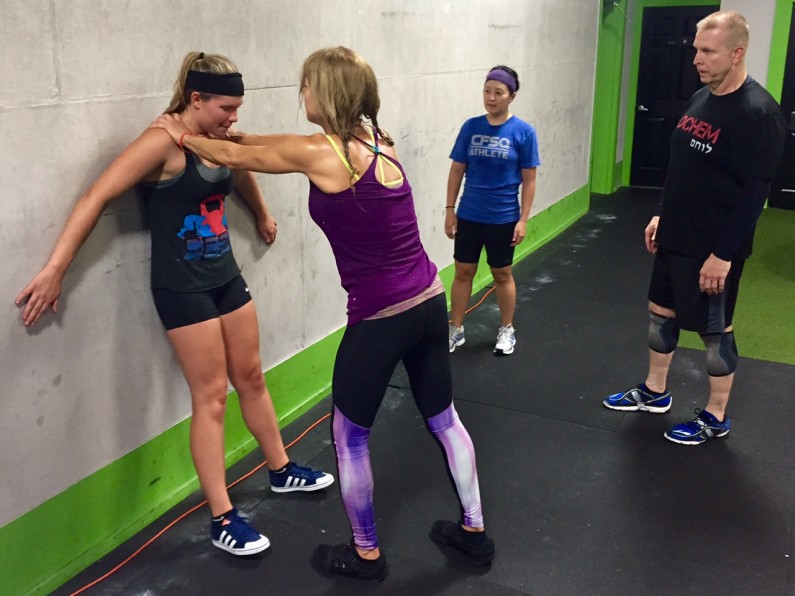Pictured above: Anna learns how to defend choke from the front against a wall in Self-Defense class. Self-D meets Tuesday & Thursday at 7 pm, Saturday at 10:30 am. However, it is CANCELLED TONIGHT.
Let’s talk muscle strains. The briefest summary of how a strain occurs is when the amount of force put on a muscle is greater than the ability of the muscle to generate an opposing force then the muscle will strain. This most often occurs during high speed movement; however, it can occur during sustained contractions.
This means that strains have a higher frequency of occurring:
- in people with previous strains because of existing muscle weakness
- after static stretching muscles because of the inhibition of muscles spindles which control the stretch-shorten cycle by regulating muscle length
- in older populations because the muscles become less pliable as age increases
- in muscles with poor flexibility and mobility because the muscle cannot elongate very far without straining especially as a person fatigues
- near the end of workouts because muscles have less ability to maintain adequate force output to prevent straining as fatigue increases
- in weak people because weak muscles are easier to strain
- with impingement where motor nerve output is decreased for whatever reason thus leading to decreased force output of the muscle and increased likelihood to strain
Prevention. Take the warmup seriously. Be intentional and don’t skip any reps. Your warmup should be fluid in nature. If static stretching causes strain, you need to do the opposite. The hip mobility series, for example, should be a dynamic flow rather than static holds in each position. It should look like this:
No one should go from 0-100mph. If you were attempting to max out your deadlift, you wouldn’t do an empty bar set and then take your first attempt. Instead, you would build up to that 1RM. Sprinting, whether on foot, the C2 or Airdyne, is no different. Your first attempt should be around 70% effort, then 80% and so on.
If you are weak you need to get stronger. If you have very tight muscles it is imperative to increase mobility in those muscles through static stretching and/or proprioceptive neuromuscular facilitative stretching after your workouts. If you’re getting up in age, you definitely need proper warmups before workouts. Save your static stretching for after workouts except for where you need it to maintain proper technique.
And, most importantly, ALWAYS maintain proper technique. If you are doing timed workouts it is important to always emphasize technique over getting a faster time. Constantly drilling technique is the key to success in every sport and athletic endeavor. You are not doing yourself any favors by short cutting yourself to look or feel better, and you increase your injury risk. It is a lose-lose situation.
Recovery. If a strain happens, take immediate action. Stop your workout. Satisfying your ego is not worth sitting on the disabled list for two weeks or more. Tell the instructor. We need to know. This is non-negotiable.
Keep moving without pain and self massage.
It is important to keep the body part moving as much as possible without causing pain. This is because of the inflammation and the scar tissue that is about to be formed. In addition, in any traumatic injury the muscles tend to tighten up and lock down to prevent further damage. These factors will impede the healing processes.
If there is excessive swelling use your hands, lacrosse ball or foam roller to push the swelling up towards the heart. This will help clear it out and speed up healing.
Massage should focus on light/superficial massage to the surface of the skin moving swelling and inflammation out towards the heart. Do not push into the tissue hard or do anything that causes significant pain as you will be interrupting the healing process, but light work is good to stimulate the blood flow and help organize regrowth.
Start using heat instead of ice.
The benefits of heating is that it helps increase blood flow to the muscles. Heat will also loosen up the tightened muscles to allow improved movement capabilities. Keep up the painless movement.
The next few days following a strain: Maintain the massage, but add light stretching afterwards
The massage is to be maintained, but the main focus of it now is to loosen up the tight muscles. Add in very light stretching work after to help increase the range of motion. This is in addition to the already frequent painless movement.
The massage + stretching here can be deeper, but still not harder to cause pain. You can start to hit those deeper tissues and stimulate blood flow to them as well as help reorganize the tissues more correctly.
Programming in this phase may follow these steps:
1. Heat to the affected muscle (10-15 minutes)
2. Massage to the muscle (10-15 minutes)
3. Light stretching focusing on improving range of motion without pain (5-10 minutes)
Anti-inflammatories, fish oil, and other vitamins to reduce swelling and promote tissue repair and regrowth. We aren’t doctors. Do your own research. Yes, we (Mario & Ivy) would take ibuprofen and other supplements to assist in recovery.
Talk to your doc and senior instructors about returning to the exercise that caused the strain.
Warmup
Jump Rope 3 Minutes
Hip Mobility Series
10 Downdog Push-ups
Alternate with a partner:
A.
3 sets
5 Hurdle Hops
Lift
Levels 3/4
10 Min E2MOM
3 Hang Power Cleans (75%)
Level 2
Hang Power Clean Practice
Levels 0/1
5 x 20
Heavy Kettlebell Swings
Then,
Level 2-4
3×3
Deadlifts
Level 0/1
5×3
KB Deadlifts
Conditioning
Alternate with a partner:
A.
3 Rounds
Explosive Complex:
30 sec each for max reps
Box Jumps
Hang Power Cleans
Burpees
Level 0-2
Sub KB swings for HPC
B.
3 Rounds
60 sec Double KB Rack Walk
60 sec rest

